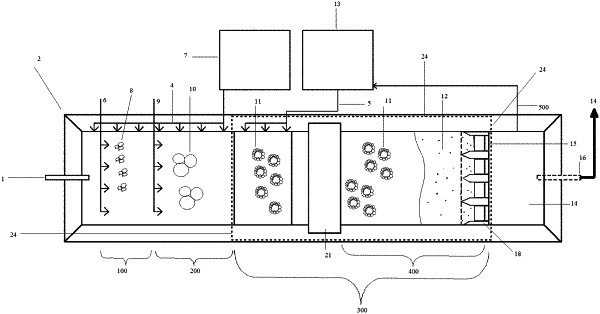| CPC B03D 1/004 (2013.01) [B01D 3/002 (2013.01); B03D 1/028 (2013.01); B03D 1/082 (2013.01); B03D 1/145 (2013.01); B03D 1/1493 (2013.01); C02F 11/008 (2013.01); B03D 2201/002 (2013.01); C02F 2103/325 (2013.01); C02F 2209/08 (2013.01)] | 5 Claims |

|
1. A vinasse treatment process by flotation in flow, carried out inside an industrial plant, in a vinasse storage tank itself, transformed into a flotation tank, commonly found in industrial plants of this type and in natural and continuous flow of vinasse production, without need of construction of new flotation tanks, the flotation tank being provided with a cover for flotation sludge, in which treatment of the vinasse is performed without need of raw cooling of the vinasse, wherein, in the flotation tank, various phases of the treatment of the vinasse are performed, which allows operation in continuous flow and with variable flows, the process comprising:
Phase 1—Coagulation through a solution of organic and vegetal coagulants, performed in a coagulation basin, at an entrance of the flotation tank, the coagulation comprising application, in the vinasse, of the solution of organic and vegetal coagulants, through an aeration and oxygenation system at a bottom of the flotation tank, through air blowers and oxygen concentrator equipment to mix coagulants, oxidation of the vinasse and formation of clots of the vinasse, which coagulated vinasse, through natural flow, inside the flotation tank, proceeds to Phase 2 of treatment;
Phase 2—Flocculation with organic and vegetal flocculants, performed in a flocculation basin, inside the flotation tank, downstream of the coagulation basin, comprising application of the organic and vegetal flocculants, in the vinasse already coagulated with the solution of organic and vegetal coagulants, formed in previous Phase 1, being the organic and vegetal flocculants mixed with the coagulated vinasse, through the aeration and oxygenation system at the bottom of the flotation tank, forming flakes having a large size, which flocculated vinasse, through natural flow inside the flotation tank, proceeds to Phase 3;
Phase 3—Flotation with injection nano and micro air bubbles, performed in a flotation basin, downstream of the flocculation basin, comprising multiple and controlled release of mixture of the vinasse treated with air, generating the nano and micro air bubbles, which are released by a pipeline in flow of the flocculated vinasse formed in previous Phase 2, the nano and micro air bubbles produced with flow and with a specific and constant diameter, appropriate to quantity and size of the flakes formed, such that, after adhesion of nano and micro bubbles in the flakes, the flakes are formed wrapped with the air, which rise to surface by thrust, forming a mass of the flotation sludge homogeneous on water surface and inside the flotation tank;
Phase 4—Retention and removal of the flotation sludge, performed in a retention and removal basin of the flotation sludge downstream of the flotation basin, inside the flotation tank, comprising retention of the flotation sludge, performed by floating fence, located at an end of the flotation basin, inside the flotation tank, which retains the flotation sludge of concentrated vinasse, allowing flow of treated vinasse to pass, under referred floating fence, which is pumped or thrown by gravity out of the flotation tank, and removal of the flotation sludge of the concentrated vinasse is performed by an adequate capture and pumping equipment, assisted by a scraper of the flotation sludge, which directs the flotation sludge to the capture and pumping equipment;
Phase 5—Recirculation of the treated vinasse, with collection of the treated vinasse at a point downstream of Phase 4 of retention and removal of the flotation sludge, to feed the treated vinasse in equipment of a vertical water/air saturation type, which provides injection of nano and micro bubbles in Phase 3 of flotation, such recirculation being in order of up to 100% (one hundred percent), depending on pollution levels of the vinasse.
|